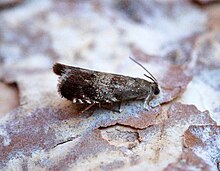| Strophedra nitidana | |
|---|---|

| |
|
Scientific classification
| |
| Domain: | Eukaryota |
| Kingdom: | Animalia |
| Phylum: | Arthropoda |
| Class: | Insecta |
| Order: | Lepidoptera |
| Family: | Tortricidae |
| Genus: | Strophedra |
| Species: | S. nitidana
|
| Binomial name | |
| Strophedra nitidana (
Fabricius, 1794)
| |
Strophedra nitidana is a moth belonging to the family Tortricidae first described by Johan Christian Fabricius in 1794. [1]
It is native to the Palearctic. [2]
The wingspan is 9-10 mm. It is similar to the closely related Strophedra weirana but has somewhat clearer markings. The forewings are quite narrow and have a bright, V-shaped cross-band with a narrow brown middle section approximately mid-stripe, besides some small, bright spots at the costal edge.
The larvae develop on oak ( Quercus spp.) where they spin two leaves together with silk and live between them. They eventually gnaw out "windows" in the leaves. The moths fly in May-June, preferably during the day.
- ^ Beccaloni, G.; Scoble, M.; Kitching, I.; Simonsen, T.; Robinson, G.; Pitkin, B.; Hine, A.; Lyal, C., eds. (2003). "Strophedra nitidana". The Global Lepidoptera Names Index. Natural History Museum. Retrieved 15 January 2021.
- ^ "Strophedra nitidana (Fabricius, 1794)". Global Biodiversity Information Facility. Retrieved 15 January 2021.
| Strophedra nitidana | |
|---|---|

| |
|
Scientific classification
| |
| Domain: | Eukaryota |
| Kingdom: | Animalia |
| Phylum: | Arthropoda |
| Class: | Insecta |
| Order: | Lepidoptera |
| Family: | Tortricidae |
| Genus: | Strophedra |
| Species: | S. nitidana
|
| Binomial name | |
| Strophedra nitidana (
Fabricius, 1794)
| |
Strophedra nitidana is a moth belonging to the family Tortricidae first described by Johan Christian Fabricius in 1794. [1]
It is native to the Palearctic. [2]
The wingspan is 9-10 mm. It is similar to the closely related Strophedra weirana but has somewhat clearer markings. The forewings are quite narrow and have a bright, V-shaped cross-band with a narrow brown middle section approximately mid-stripe, besides some small, bright spots at the costal edge.
The larvae develop on oak ( Quercus spp.) where they spin two leaves together with silk and live between them. They eventually gnaw out "windows" in the leaves. The moths fly in May-June, preferably during the day.
- ^ Beccaloni, G.; Scoble, M.; Kitching, I.; Simonsen, T.; Robinson, G.; Pitkin, B.; Hine, A.; Lyal, C., eds. (2003). "Strophedra nitidana". The Global Lepidoptera Names Index. Natural History Museum. Retrieved 15 January 2021.
- ^ "Strophedra nitidana (Fabricius, 1794)". Global Biodiversity Information Facility. Retrieved 15 January 2021.